The 5 Most Venomous Spiders
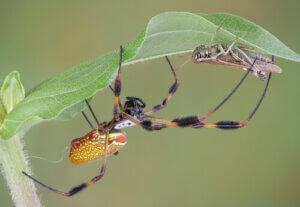
We fear them, we’re repulsed by them, and they scare us when we see one at home. It should be said that some of them are harmless, but in this article we’re not going to talk about those. Instead, you’re going to meet the most venomous spiders that exist. This way, you’ll be able to recognize them and escape if by some chance you come across one.
What are the most venomous spiders?
Some people think the most venomous spiders are the ugliest or the biggest ones, but this isn’t true. Some of them are small, and as for their beauty, that depends on your perception. What we can say for sure, and objectively, is which ones can inject the most toxic venom:
1. The Brazilian wandering spider
Also called the ‘banana spider‘, this is the most toxic spider in the world according to studies. As if this weren’t enough, they also look very scary—they’re as big as the palm of your hand—and are quite aggressive.
The Brazilian wandering spider—like the one in the photo at the top of the article—has two large eyes in front and two smaller ones on its sides. Its body and legs are hairy.
They live in jungles in Peru and Brazil, especially in banana plantations. If they bite a person, they will experience loss of muscle control, breathing difficulties, and death by asphyxiation within a few hours, if they don’t get treatment in time.
2. The brown recluse spider
Also known as the fiddleback spider, these arachnids hide in hard-to-reach places. They’re native to South America and are the most dangerous of the Loxosceles genus because their bite can be lethal. The venom they inject is 15 times more toxic than that of a cobra.
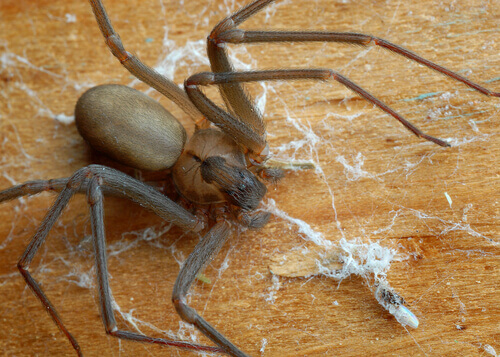
The fiddleback spider is brown and measures about 1.2 inches with legs extended. They have a black line on the thorax which resembles a violin. They’re nocturnal and tend to increase their activity in hot weather.
3. The most venomous spiders: the black widow
This is another of the most venomous spiders in existence and one of the most famous, so much so that there are characters, movies, musical groups and television shows named after them. They’re called black widows because the female eats the male after reproduction.
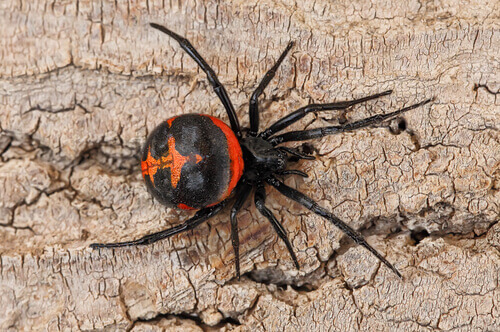
Although their bite isn’t lethal to humans, it’s quite harmful due to its size. Their venom glands are large in comparison to their body. In addition, the bite of a female is three times more powerful than that of a male.
4. The funnel-web spider
This large spider (females measure about 2.8 inches and males 2 inches), is native to Sydney, Australia. It’s very dangerous because it has large venom sacs ‘at the ready’ and will use them as needed.
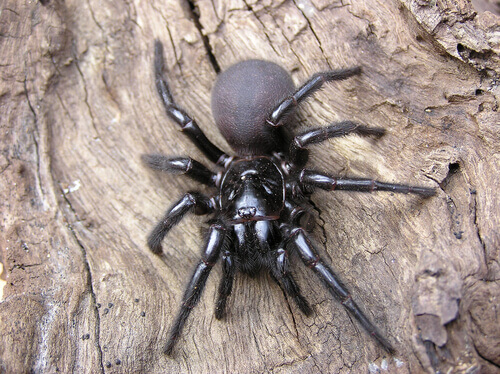
Their bodies are black with shiny, hair-covered legs, and their fangs and claws are visible. They usually live under rocks and fallen timber, as they prefer damp, dark places. They can kill children with their bite and, in this case, the male is more deadly than the female.
5. The wolf spider
The last of the most venomous spiders on this list is also called the hunting spider, and, although they’re very dangerous, the truth is that they don’t usually attack, preferring to flee in the face of danger. Most wolf spider bites happen when they’re hidden in a shoe or glove and get trapped. In more serious cases, a bite can cause localized muscle necrosis.
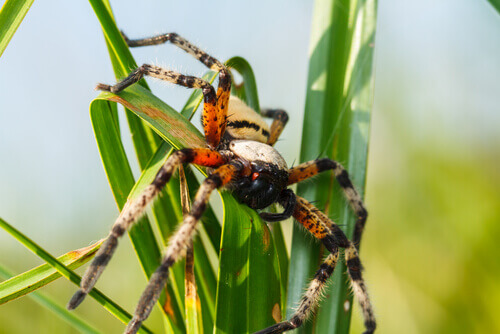
The wolf spider inhabits the temperate and warm regions of South America, especially Brazil. They have eight eyes in three rows, long, spiny legs and are predominantly black with red or yellow spots. They measure about 1.2 inches, feed on cockroaches, moths, and crickets, and are mainly nocturnal.
We fear them, we’re repulsed by them, and they scare us when we see one at home. It should be said that some of them are harmless, but in this article we’re not going to talk about those. Instead, you’re going to meet the most venomous spiders that exist. This way, you’ll be able to recognize them and escape if by some chance you come across one.
What are the most venomous spiders?
Some people think the most venomous spiders are the ugliest or the biggest ones, but this isn’t true. Some of them are small, and as for their beauty, that depends on your perception. What we can say for sure, and objectively, is which ones can inject the most toxic venom:
1. The Brazilian wandering spider
Also called the ‘banana spider‘, this is the most toxic spider in the world according to studies. As if this weren’t enough, they also look very scary—they’re as big as the palm of your hand—and are quite aggressive.
The Brazilian wandering spider—like the one in the photo at the top of the article—has two large eyes in front and two smaller ones on its sides. Its body and legs are hairy.
They live in jungles in Peru and Brazil, especially in banana plantations. If they bite a person, they will experience loss of muscle control, breathing difficulties, and death by asphyxiation within a few hours, if they don’t get treatment in time.
2. The brown recluse spider
Also known as the fiddleback spider, these arachnids hide in hard-to-reach places. They’re native to South America and are the most dangerous of the Loxosceles genus because their bite can be lethal. The venom they inject is 15 times more toxic than that of a cobra.

The fiddleback spider is brown and measures about 1.2 inches with legs extended. They have a black line on the thorax which resembles a violin. They’re nocturnal and tend to increase their activity in hot weather.
3. The most venomous spiders: the black widow
This is another of the most venomous spiders in existence and one of the most famous, so much so that there are characters, movies, musical groups and television shows named after them. They’re called black widows because the female eats the male after reproduction.

Although their bite isn’t lethal to humans, it’s quite harmful due to its size. Their venom glands are large in comparison to their body. In addition, the bite of a female is three times more powerful than that of a male.
4. The funnel-web spider
This large spider (females measure about 2.8 inches and males 2 inches), is native to Sydney, Australia. It’s very dangerous because it has large venom sacs ‘at the ready’ and will use them as needed.

Their bodies are black with shiny, hair-covered legs, and their fangs and claws are visible. They usually live under rocks and fallen timber, as they prefer damp, dark places. They can kill children with their bite and, in this case, the male is more deadly than the female.
5. The wolf spider
The last of the most venomous spiders on this list is also called the hunting spider, and, although they’re very dangerous, the truth is that they don’t usually attack, preferring to flee in the face of danger. Most wolf spider bites happen when they’re hidden in a shoe or glove and get trapped. In more serious cases, a bite can cause localized muscle necrosis.

The wolf spider inhabits the temperate and warm regions of South America, especially Brazil. They have eight eyes in three rows, long, spiny legs and are predominantly black with red or yellow spots. They measure about 1.2 inches, feed on cockroaches, moths, and crickets, and are mainly nocturnal.
All cited sources were thoroughly reviewed by our team to ensure their quality, reliability, currency, and validity. The bibliography of this article was considered reliable and of academic or scientific accuracy.
- Diniz, M. R., Paiva, A. L., Guerra-Duarte, C., Nishiyama Jr, M. Y., Mudadu, M. A., Oliveira, U. D., … & Junqueira-de-Azevedo, I. D. L. (2018). An overview of Phoneutria nigriventer spider venom using combined transcriptomic and proteomic approaches. PloS one, 13(8), e0200628.
- Postma, T. L. (2009). Neurotoxic animal poisons and venoms. Clinical Neurotoxicology, 55(2-3), 463-489.
- Reyna, G. A. R., Velazco, J. S., Saed, N. S., Vera, F. X. H., & Heredia, J. B. (2009). Necrosis cutánea por loxoscelismo. Reporte de caso. Revista Mexicana de Angiología, 37(3), 93-96.
- Mullen, G. R., & Vetter, R. S. (2019). Spiders (Araneae). In Medical and veterinary entomology (pp. 507-531). Academic Press.
- Gómez, J. C., Sánchez, B. S., Huerta, H., & Trejo, A. V. (2020). Primer registro de la viuda café Latrodectus geometricus en Sonora, México. Revista Biomédica, 31(3), 139-143.
This text is provided for informational purposes only and does not replace consultation with a professional. If in doubt, consult your specialist.








